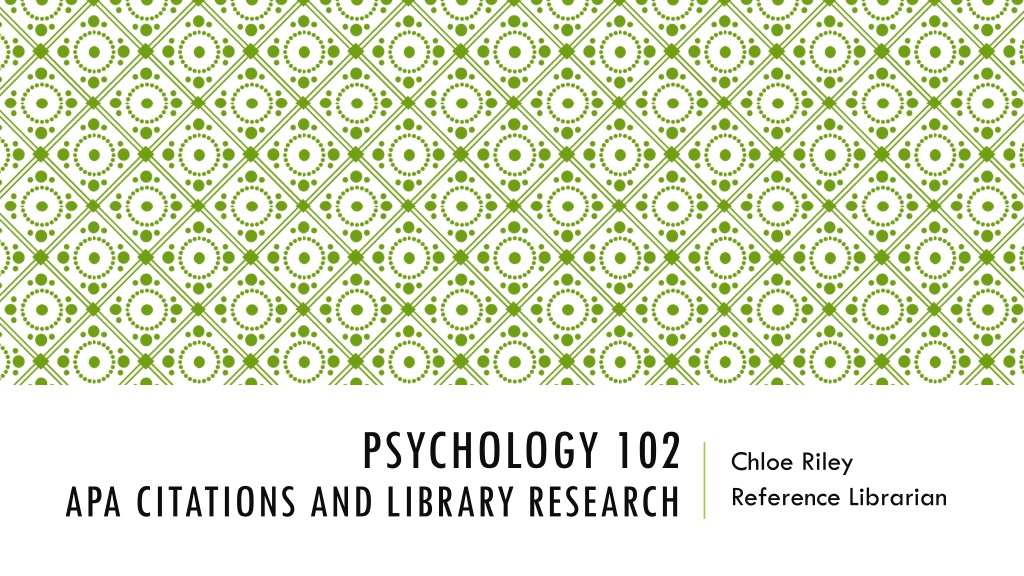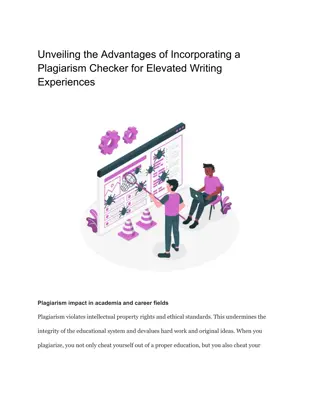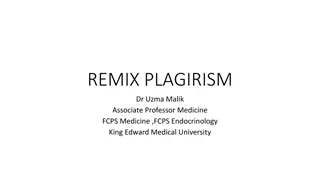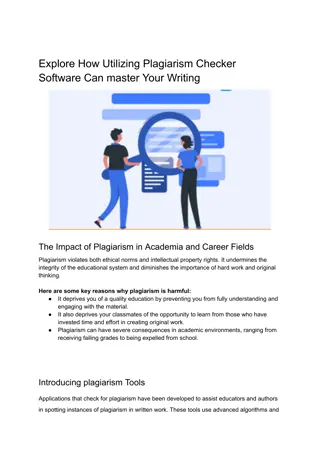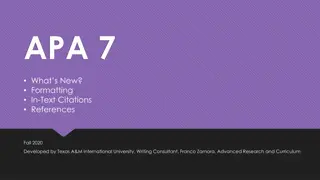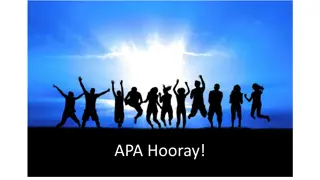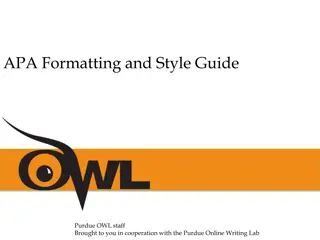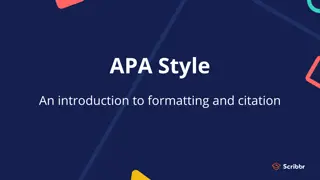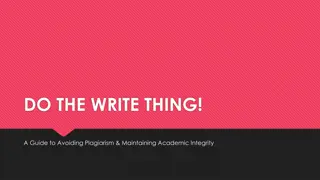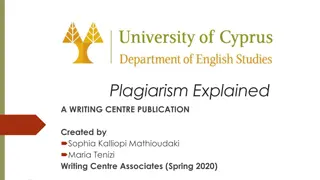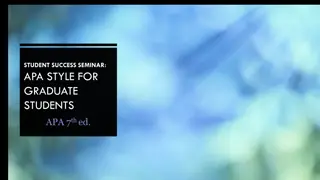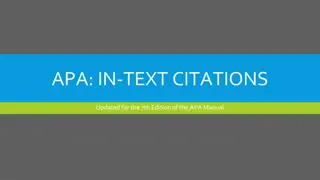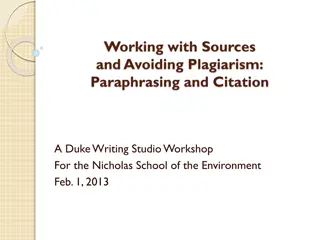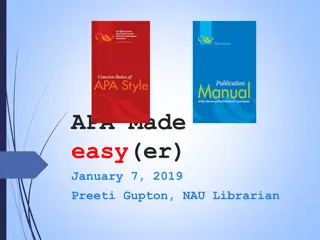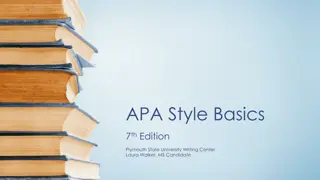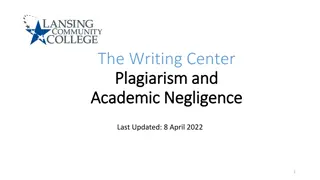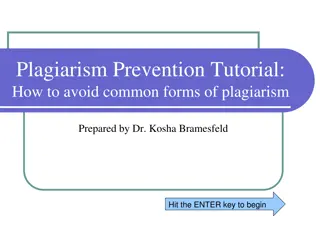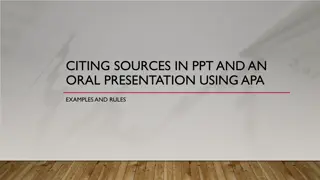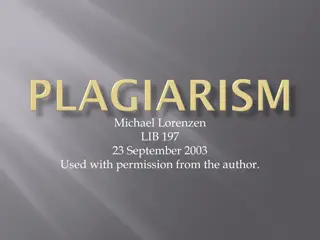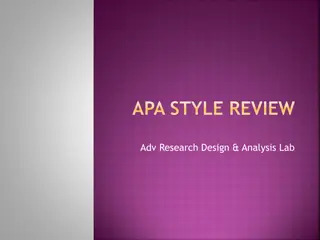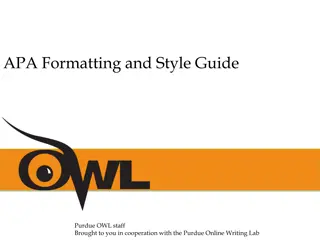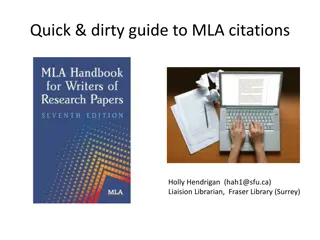Mastering APA Citations and Avoiding Plagiarism in Research
Understanding the importance of citations in academic writing, this resource provides insights on plagiarism, summarizing vs. paraphrasing, patchwriting, and working with APA Style. Discover how to effectively cite sources, prevent unintentional plagiarism, and enhance your research skills.
Download Presentation

Please find below an Image/Link to download the presentation.
The content on the website is provided AS IS for your information and personal use only. It may not be sold, licensed, or shared on other websites without obtaining consent from the author. Download presentation by click this link. If you encounter any issues during the download, it is possible that the publisher has removed the file from their server.
E N D
Presentation Transcript
PSYCHOLOGY 102 Chloe Riley Reference Librarian APA CITATIONS AND LIBRARY RESEARCH
AGENDA Understanding plagiarism Summarizing vs paraphrasing Patchwriting Working with APA Style citations Finding articles Getting more help
UNDERSTANDING PLAGIARISM Plagiarism: The unacknowledged use of other people's ideas or work. Plagiarism is often unintentional and can be avoided through careful work habits. Whether intentional or unintentional, plagiarism is recognized as a serious academic offence. Source: http://www.awesomelyluvvie.com/2012/01/protect- your-blog-content-know-your- rights.html/cartoon_plagiarism_444045
WHY ARE CITATIONS SO IMPORTANT IN ACADEMIC WRITING AND RESEARCH? Acknowledges that you have borrowed information from other authors and therefore protects you from committing plagiarism Allows your readers to easily locate the sources you have referenced
SUMMARIZING VS. PARAPHRASING Summarizing Paraphrasing Similar to a paraphrase but much shorter than the original. When you paraphrase, you restate others ideas in your own words but include roughly the same level of detail. You express the author s main idea(s) in your own words. You write the meaningof the author s ideas. Include only the essential points. You might use a key term by the author but you primarily use your own words and sentence structures. Include an in-text citation with the author s last name and year of publication. Include an in-text citation with the author s last name and year of publication.
PATCHWRITING You copy a short passage from an article you found. You change a couple of words, so that it's different than the original. You carefully cite the source. Patchwriting occurs when a student paraphrases a passage but leaves it too similar to the original. In patchwriting, the writer may delete a few words, change the order, substitute synonyms and even change the grammatical structure, but the reliance on the original text is still visible when the two are compared.
PATCHWRITING Original: Where mainstream sports typically refrain from displaying unapologeticallyviolent acts, professional wrestling dives in head first. A large portion of wrestling s cultural appeal is generated by the psychological arousal/excitement provided by witnessing highly aggressive and violent forms of physical interaction in this sphere. Wrestling takes that which is pushed behind the scenes of social life and places it in the centerring (Atkinson, 2002, p. 62-63). Patchwriting: Mainstream sports refrain from showing unremorseful violent acts while professional wrestling unapologetically revels in the same type of violence. A large part of wrestling s appeal is generated by the very aggressive and violent interaction in this sport. While such violence is usually behind the scenes of social life, it is the centre of wrestling s existence. (Atkinson, 2002, p. 62-63)
ACCEPTABLE PARAPHRASE Most sports do not encourage blatant acts of violence, while professional wrestling embraces the same behaviour. Wrestling appeals to audiences because people enjoy watching aggressive and violent acts in the ring. What is normally not condoned in ordinary society is made acceptable in wrestling. (Atkinson, 2002, p. 62-63)
PLAGIARISM CAN BE Intentional Copying Purchasing a paper/contract cheating Collusion Unintentional Self-plagiarism Patchwriting Forgetting to include a citation Take the SFU Library Plagiarism Tutorial in Canvas.
WORKING WITH CITATIONS What is a citation (or a reference)? Definition: A short summary of the necessary information you need to find a unique information resource such as a book or an article or a website. Usually includes: title, author s name, publication date, etc.
THE PUBLICATION MANUAL OF THE AMERICAN PSYCHOLOGICAL ASSOCIATION (APA), 6TH EDITION You must cite all of the articles/books/chapters you use following APA guidelines There are many online guides to help you navigate APA citation rules (SFU APA Guide, Owl Purdue, APA Style Blog) Some databases will format APA citations for you to copy & paste Citation managers can store your citation information for you and generate bibliographies automatically!
WHERE DO I CITE? 1. Within the body of your text (in-text citation) 2. At the back of your paper (References/Works Cited) In-text citation: Young adult literature frequently (Bucher & Manning, 2006, p. 8). Reference list citation: Bucher, K., & Manning, M. L. (2006). Young adult literature: Exploration, evaluation, and appreciation. Upper Saddle River, NJ: Pearson Education.
PARTS OF A CITATION Terry, P., Doumas, M., Desai, R. I., & Wing, A. M. (2009). Dissociations between motor timing, motor coordination, and time perception after the administration of alcohol or caffeine. Psychopharmacology, 202(4), 719-729. doi:10.1007/s00213-008-1352-z
PARTS OF A CITATION Terry, P., Doumas, M., Desai, R. I., & Wing, A. M. (2009). Dissociations between motor timing, motor coordination, and time perception after the administration of alcohol or caffeine. Psychopharmacology, 202(4), 719-729. doi:10.1007/s00213-008-1352-z Journal Volume No. Author(s) Publication Year Journal Issue No. Title of Article Page Nos. of Article Title of Journal DOI
WHAT CAN YOU CITE? ANYTHING! Book with one author: Walker, L. E. (2000). The battered woman syndrome (2nd ed.). New York: Springer. Book with three authors Sharp, J. A., Peters, J., & Howard, K. (2002). The management of a student research project. Aldershot, England: Gower. Chapter in an anthology Sharp, S. F., & Eriksen, M. E. (2003). Imprisoned mothers and their children. In B. H. Zaitzow & J. Thomas (Eds.), Women in prison: Gender and social control (pp.119- 136). London: Lynne Rienner Publishers. Scholarly journal article Turner, J. (2007). Justice and emotions. Social Justice Research, 20(3), 288- 311. doi:10.1007/s11211-007-0043-y Website / Report National Institute of Mental Health. (2014). Eating disorders: About more than food. Retrieved from http://www.nimh.nih.gov.health/publications/eating- disorders-new-trifold/eating disorders-pdf_148810.pdf Source: Lee, C. (2010), retrieved from http://blog.apastyle.org/apastyle/2010/11/how- to-cite-something-you-found-on-a-website-in-apa-style.html Etc.
FIRST STEPS IN THE RESEARCH PROCESS Choose a topic Identify key concepts Brainstorm other possible synonyms or related search terms Select a database Try out a search!
SCHOLARLY ARTICLES By scholars for scholars 8-30 pages Specialized language Extensive bibliographies Latest research Peer reviewed
FINDING ARTICLES: SEARCH DEMO Use PsycINFO Example topic: Can public high school sex education classes significantly reduce student pregnancy rates? Key concepts: Related Terms: Sex education sex ed, sexual education High school secondary school, adolescents, teens Pregnancy pregnant, parents, mother
DATABASE SEARCH TIPS Use AND to narrow or focus the search Example: violence AND teenagers Use OR to expand your search results Example: teenager OR youth OR adolescent Use quotation marks to find specific phrases Example: video games Use an asterisk (*) to find related terms Example: Canad* will search for Canada, Canadian
WHERE TO GET MORE HELP? Ask a Librarian (research help) Research & citation help: in person, email, phone, online chat Psychology Librarian: Yolanda Koscielski ysk6@sfu.ca Citation style guides Student Learning Commons Academic writing help Study skills
